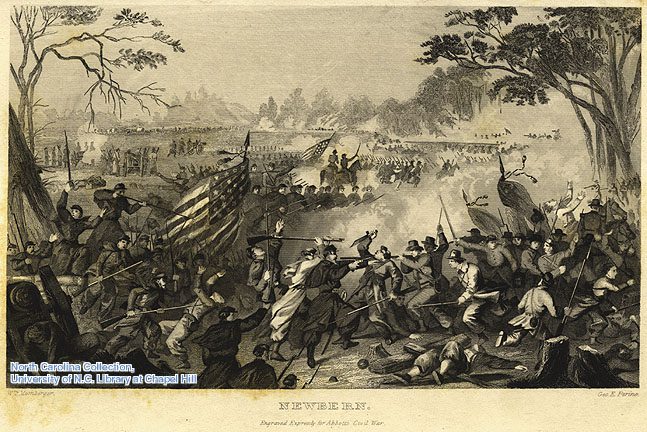
Former civil rights lawyer and activist Floyd McKissick watches work begin on his "Soul City" project, a long-gestating Black empowerment utopia that ultimately couldn't escape the bad press from white supremacists. (AP Photo/Harold Valentine)
A Black refuge for economic empowerment, a lesbian commune, and a refuge for enslaved people: Let’s take a tour of the hidden societies within North Carolina society.
Ever since the colony’s early adoption of religious freedom in 1672, North Carolina has been a haven to idealists seeking to build intentional communities or hideouts (depending on the nature of the ideals).
Read More: How to test your water for PFAS and other bad things in NC. Click here.
From Soul City in the 1970s, a community devoted to Black economic empowerment, to the still extant Crusoe Island, believed to be founded by the white survivors of the 1804 Haitian Revolution, join us as we uncover NC’s secret utopias.
Lesbian Separatists, McLeansville, NC
When given the choice between buying Taylor Swift’s genuine leather “F*** the Patriarchy” keychain or building feminist refuges governed by socialist values, the Womyn’s Land Movement of the 1970s chose the latter. There’s woke and then there’s woke.
Bold Moon Farm, established in 1985 in McLeansville, NC, was one such women-only commune founded on the belief that women must separate themselves from men to achieve female liberation. Visitors to the now Bold Moon Preserve can see the remains of this feminist paradise lost in the abundant fruit trees, mature hardwoods, and rushing Reedy Fork Creek.
The original commune closed in 2000. Like many of Womyn’s Land communities, they encountered criticism both from conservative rural neighbors and, perhaps more surprisingly, the contemporary LGBTQ community for an anti-trans definition of womanhood. There just aren’t enough newcomers to carry on the dream.
Floyd McKissick’s Soul City, NC

Soul City, located an hour outside of Raleigh, wasn’t meant to be a “separatist” city. In 1969, Soul City founder and native North Carolinian Floyd McKissick imagined an integrated city that was founded on equitable rights and opportunity for all people.
But in 1969, equitable rights and opportunity meant a lot of catchup for the Black community, not to mention some radical changes to the status quo. White people wouldn’t be excluded from Soul City. But in McKissick’s vision, Black people would be in charge: of the police department, school board, healthcare offerings, and businesses. McKissick projected Soul City would have 24,000 jobs and a population of 50,000 by the year 2000.
So, of course, Soul City was immediately widely misunderstood, branded as an experiment in Black Nationalism, and accused of racism (because there is nothing new under the sun). Even though the Nixon administration awarded the city a $14 million loan guarantee (~$90 million today) to gain acceptance among Black voters — the city failed to thrive beyond its false reputation.

The French-Haitian Settlement, Riverview, NC
While these days, Crusoe Island is neither an island nor actually called Crusoe on any map, it still retains its separatist heritage through the descendants of the original Creole inhabitants. Even though the island was officially connected to the mainland by a bridge in the 1940s, there’s only one road into (now) Riverview, NC, and if the neighbors don’t recognize your car, things could get ugly. We don’t suggest you visit.
According to legend, Crusoe Island was founded in 1804 by the only white survivors of the Haitian Revolution, the overthrow of the French regime in Haiti by Africans and their descendants who had been enslaved. And they may have been a little traumatized by this crisis of their own making.
At the time, Crusoe Island was a raised tract of land in the middle of North Carolina’s Green Swamp near Lake Waccamaw. The only way to get on or off the island was by boat, and that’s how the islanders liked it. Today, in addition to their xenophobia, the islanders are known for their self-sufficiency, unique lilting dialect, and past expertise in canoe building.
The Maroons, The Great Dismal Swamp

Beginning in the early 1600s, a 20 acre-island hidden within the nearly impenetrable foliage and muck of The Great Dismal Swamp became a refuge for Native Americans escaping European colonialism. As the 1600s progressed, it developed into a majority Black proto-Marxist agricultural community that lasted until the late 1800s.
For the Maroons, people who had escaped slavery to live permanently in the swamp, freedom and self-determination came at a high cost. The swamp was full of panthers, water moccasins, rattle snakes, and mosquitos–whose landing rate was once inexpertly described as 100 mosquitoes per human forearm per minute.
Archaeologists have slowly begun uncovering artifacts and foundations of log-cabins on the island. However, the island is largely inaccessible inside The Dismal Swamp State Park and cannot be visited by the public because of the same dense brush that kept the Marooners safe from their enslavers.
The Amish, Union Grove, NC
According to a 2021 metastudy, the world’s Amish population doubles every twenty years. Which might explain why, despite prohibitions against electricity (no air conditioning) and requirements for Amish garb (dark, muted colors and lots of coverage), Amish have repeatedly tried to move to North Carolina.
Today, Union Grove, a rural township halfway between Winston-Salem and Boone, is the only active Amish settlement in North Carolina. The Amish of Union Grove are new-order: they can use electricity but still use animal traction for transportation.
Unlike many of North Carolina’s lost paradises, outsiders can visit parts of Union Grove to enjoy Amish crafts, carpentry, and tasty treats.
The Mennonite Brethren, Boone, NC
Historically, the Mennonite Brethren have practiced isolationism: removing themselves from the secular world, only speaking their native tongue (German), and embracing pacificism by refusing to participate in war or politics. Many still adhere to a strict dress code which includes a plain coat with no lapels for men and a lace head covering for women.
While the Mennonite Brethren of North Carolina follow some of these principles, they would probably be unrecognizable to traditional Mennonites elsewhere in the USA. For one, the North Carolina District is the only MB Conference in the USA with a majority of black members. They might also be confused by the enthusiastic worship style which includes waving, clapping, shouts, and holy dancing influenced by the Black Baptist tradition.
But, the MB in North Carolina still adhere to the Mennonite brand of pacifism, in contrast to other local, traditionally Black worship communities. Black Boone Mennonites, for example, avoided civil rights activism during the 1960s and, these days, church leadership still do not participate in advocacy organizations such as the NAACP.

Thousands in NC prisons endure summer heat without air conditioning
Despite North Carolina's brutally hot summers, about 21% of NC prisons are without air-conditioning. by Rachel Crumpler, North Carolina Health News...

Blue Ridge Parkway: Which Helene-damaged areas might reopen in late summer, early fall?
Heading into the summer season, large sections of the Blue Ridge Parkway's winding path through the mountains of Western North Carolina remain...

Learn about NC Civil War history at these 8 spots
If you want to learn more about NC Civil War history, check out these eight sites across the state. One of the most famous and bloody conflicts in...

Learn about NC Civil War history at these 8 spots
If you want to learn more about NC Civil War history, check out these eight sites across the state. One of the most famous and bloody conflicts in...

North Carolina officials celebrate opening of new Paddy Mountain Park
Paddy Mountain Park is officially open in West Jefferson. Discover North Carolina's newest outdoor destination born from community collaboration and...







